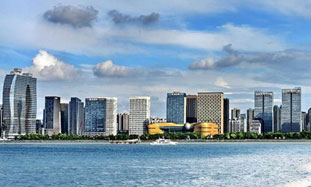Industrial Clusters
Wenzhou-Taizhou Coastal Industrial Area
Wenzhou-Taizhou area includes Wenzhou and Taizhou, two prefecture-level cities, and covers a total land area of 21,190 square kilometers, accounting for 20% of Zhejiang’s total land area. As the origin of the well-known "Wenzhou-Taizhou Mode", this area features a highly market-oriented economy, a bustling private economic sector, a well-developed regional block economy and an abundant private capital supply.
Wenzhou-Taizhou area lies adjacent to Ningbo and Shaoxing to the north; borders Fujian to the south, Jinhua and Lishui to the west and looks out to the East China Sea to the east. Located right on the southern edge of the economically developed areas in the middle of China’s coastline, Wenzhou-Taizhou area enjoys convenient land and sea transportation. What’s more, as it is situated between southern Zhejiang and northern Fujian and in the proximity of Taiwan, this area shares similar local cultures with Taiwan. As a result, it is a key attraction for Taiwanese investment in Zhejiang Province. With the construction of Jinhua-Lishui-Wenzhou Expressway, Taizhou-Jinyun Expressway and Ningbo-Taizhou-Wenzhou Railway, the geographic advantages of Wenzhou-Taizhou area will be further enhanced.
With abundant marine, tourism, tidal flat and nonmetal mineral resources, Wenzhou-Taizhou area is one of the areas that enjoy rich natural resources in Zhejiang Province. After more than 20 years of rapid development, Wenzhou-Taizhou area has accumulated an enormous private capital. And most enterprises in this area have completed their proto accumulation of capital and are planning on further expansion and upgrading. Some key enterprises have started to "go out" for further development, and this also helps the spreading of the "Wenzhou-Taizhou Mode".
Wenzhou-Taizhou area boasts a batch of feature industries such as manufacturing industries whose products include automobiles, motorcycles and accessories, medicine and chemical products, molds and plastics, garment machinery, water pumps and valves, artworks, home appliances, green agricultural products, and shoes, caps and garments; and processing industries such as aquatic products processing, and daily necessities processing, etc. A large number of professional markets with great vitality and the small towns where they are located are also important constituents of the economy in this area. The interactive development of feature industries, professional markets and small towns in some regional block economies has laid a solid foundation for the development of international industry clusters and a well-developed manufacturing base.
Wenzhou-Taizhou area is the birthplace of the famous "Wenzhou-Taizhou Mode", and China’s family enterprises, shareholding cooperative enterprises, and private enterprises were all originated there. It is also the pilot area of China’s financial reform. It features a robust private sector, flexible mechanism, well-developed market system and a vigorous economic mechanism. Its market-orientation process and the development of intermediate agencies such as various kinds of industry associations are also leading in China.
The rise of the historic "Yongjia School" has brewed the tradition in Wenzhou-Taizhou area that lays equal emphasis on "morality and benefits" and regards both industry and commerce as fundamental. As an area stuck between high mountains and sea, the area has suffered from a shortage of land resources. The strained relations between land and men have pushed the locals to leave their hometown and to use their intelligence and technical skills for their daily bread. And their bold explorations ever since China’s economic reforms have helped to foster a unique regional culture and the so-called "Wentai Spirits" which emphasize on courage, pragmatism, flexibility and creativity.
The strategic positioning of the overall development of Wenzhou-Taizhou coastal area can be summed up as: fully utilizing its geographic advantages and the period of important strategic opportunities so as to realize the harmonious development of industry, city and ecology; developing itself into an international industrial-cluster-assembling area, a private economy exemplary area and a pioneering area in the simultaneous development of coastal and inland areas, which can develop interactively with the Around-Hangzhou Bay Region, can have radiation effects on the economic growth of Jinhua, Quzhou and Lishui and can act in cooperation with the Yangtze River Delta Region and the Pearl River Delta Region.
The development structure for Wenzhou-Taizhou coastal area can be summed up as: "one axis, two clusters and three belts".
1. "One axis"
This "axis" refers to the area along the three trunk lines of Ningbo-Taizhou-Wenzhou Railway, Taizhou-Wenzhou Expressway and the Coastal Expressway. As the economic artery of Wenzhou-Taizhou area, it will help to promote the harmonious development of all cities, towns and industrial belts along the axis and accelerate the formation of the international industrial clusters and the coastal city clusters.
2. "Two clusters"
(1) International industrial clusters with distinct advantages: strenuous efforts will be made to foster the formation of the three equipment manufacturing industrial clusters of electrical machinery, traffic and transportation equipment and light industrial machinery so as to make them the pillar industries of Wenzhou-Taizhou area in global economic competition; efforts will also be made to upgrade the six light industrial clusters of garments and adornments, daily commodities, craftworks and furniture, home appliances, general machinery and packing and printing so as to make them the fundamental strength of Wenzhou-Taizhou area in national and global market competition.
(2) Fully functional coastal city clusters: Wenzhou and Taizhou’s status as central cities will be highlighted so as to make them the centers of the two growing city clusters, namely, the Municipality of Metropolitan Wenzhou and the Municipality of Taizhou. Efforts will be made to further enhance the functions of the regional center cities, and improve the developmental qualities of center cities and towns so as to form an urban system which features orderly composition, complementary functions, and rational layout. Improve and perfect the service functions of the key industrial parks so that several modern coastal urban districts may be created.
3. "Three belts"
(1) "Golden Industrial Belt" refers to the advanced manufacturing industrial belt that runs along Ningbo-Taizhou-Wenzhou Railway, Taizhou-Wenzhou Expressway and the Coastal Expressway. This manufacturing industrial belt is centered on the international industrial clusters and located in the coastal city clusters.
(2) "Blue Industrial Belt" refers to the marine industrial belt that focuses on port industry, aquatic product intensified processing industry, marine fishing industry and marine tourism industry. This industrial belt will mainly be located in islands, harbor zones and coastal cities and towns.
(3) "Green Industrial Belt" refers to the ecological industrial belt that focuses on the growing and processing of green agricultural products, tourism and leisure industry, and ecology-oriented industry. The industrial belt, based on the principle of coordination between urban and rural areas, is mainly located in small cities in inland mountainous areas and central towns.

 Print
Print Mail
Mail
 20 Cultural Symbols
20 Cultural Symbols Why Zhejiang
Why Zhejiang Experiencing high-tech products at WIC
Experiencing high-tech products at WIC Zhejiang Release
Zhejiang Release Zhejiang News
Zhejiang News